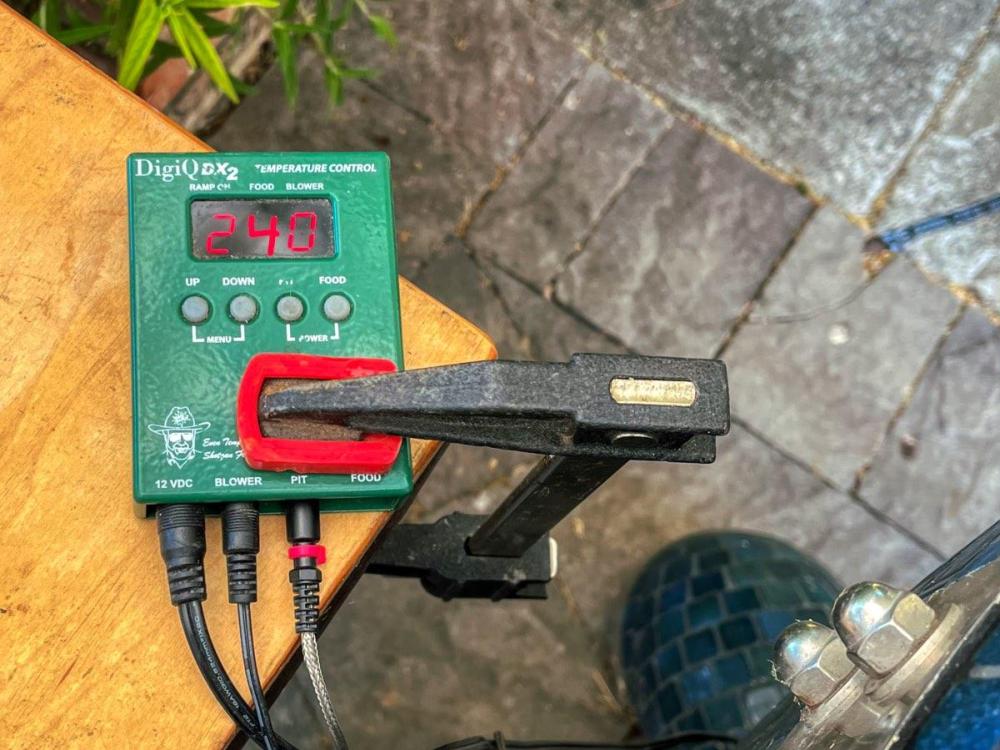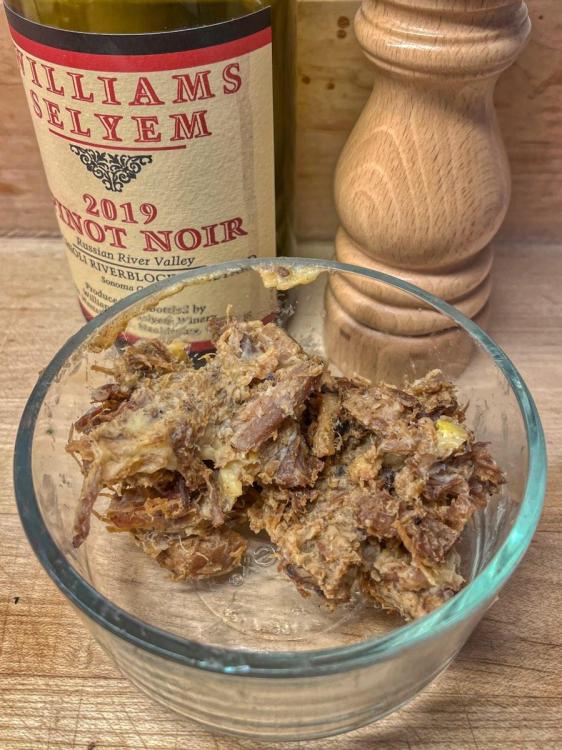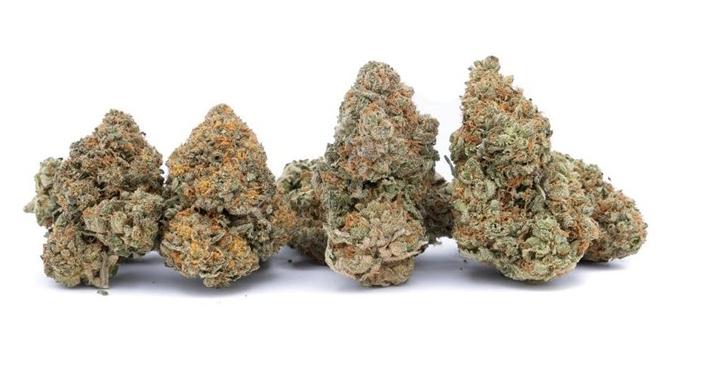-
Posts
1,744 -
Joined
-
Last visited
-
Days Won
53
Content Type
Profiles
Forums
Events
Everything posted by Syzygies
-
Komodo Kamado Grill Basics -- The Secrets Of Kamado Cooking (As Dennis shared in the KK forum thread KK Videos)
-

Less than Good News.. Rotator Cuff Surgery..
Syzygies replied to DennisLinkletter's topic in KK Announcements
Take good care of yourself in recovery! You'll need a good story to tell people. Like, you were visiting an elephant preserve, and the vets offered to let you try ... -
-
Looks like a K5, not a K7, to me. A buddy bought a K5 when I bought a K7. Mine dissolved into the ground; his still (sort of works). A KK is worth the money. Anything of similar appearance to this K5, new in a hardware or box store, is a better value than this K5.
-
Taco party yesterday. We make too much food, and it all went. This is what was left of carnitas from two kilos of pork butt. Carnitas is typically a stovetop pork butt braise. However, it just felt wrong not involving the KK and smoke somehow, and one of my guests always want ribs. This could have been the best version I've ever made; I started by smoking 1 1/2" slices for several hours in a cazuela, using apple wood in a one quart smoke pot. The meat was easily trimmed of excess fat at this point, and the cazuela drippings replaced the recipe lard. Proceed as normal from here, stovetop recipe.
-

Recipes for Chilli Sauces Please!!!
Syzygies replied to tekobo's topic in Sauces, Mops, Sops, Bastes, Marinades & Rubs
It's been a few years, but I've made many batches of fermented Tabasco-style hot sauce over the years. Like many of us, I have a chamber vacuum machine. The signature uses of sous vide and freezer preservation easily justify a machine. Nevertheless, we should all take inspiration from those "what goes in a blender?" YouTube videos. What goes in a chamber vacuum machine? A couple of sixty second sessions will hydrate any dough better than a long rest. This has an extraordinary effect on pasta dough. A quick refrigerator pickle such as a Mexican Cauliflower and Jalapeño Escabeche (Asada: The Art of Mexican-Style Grilling by Bricia Lopez and Javier Cabral has the best recipe I've seen) benefits from vacuum packing and a rest. Some people ferment chiles for hot sauce by vacuum packing the peppers with a starter, in a large pouch with room for the gases. The challenge in fermenting chiles is getting white cloudy Kahm Yeast. While it isn't harmful, it's gross, and in my opinion it affects the flavor. The fermenting world is full of people who've never figured out how to avoid Kahm yeast, who consider worrying about it a silly concern. I usually don't get Kahm yeast, but I consider myself an abject failure of a human being when I do. The hope is that removing oxygen by chamber vacuum sealing the chiles will prevent Kahm Yeast. I also have an argon tank, for saving part bottles of wine, and I intend to experiment with displacing the air in a carboy, as an alternate approach. I adjust pH to below the botulism threshold whatever I do, measuring with a professional pH meter. You can get banned from a fermentation forum by suggesting such a thing, but it brings me peace of mind. Many botulism deaths are the result of ill-advised experiments that break with long understood tradition, such as Alaskan natives fermenting meats in a plastic pail rather than in the traditional sealskin. One should recognize that any novel approach to fermenting hot sauce poses similar questions. -
Rob, I'm sorry! My new meds are working, and I no longer fall down rabbit holes like this. The way to think about any problem like this is to get so much practice that one doesn't need to think at all.
-

Goldie’s BBQ Brisket Resting Technique = Excellent Results
Syzygies replied to KK787's topic in KK Cooking
There may be a divergence between appearance and reality, here. In competition one starts meat cold, to maximize the smoke effect. There's a cutoff temperature after which a smoke ring won't form. And judges, who have their palates blown by competitors with coarse smoke handling, look for this ring. There's a camp that finishes in the oven, perhaps after transport, because smoke no longer matters after the ring has formed. I see the error in this logic, but I don't know for a fact that smoke at later stages matters that much. When I was commuting to NYC I'd smoke BBQ part way, chill it, vacuum pack it and freeze it, then friends would finish it any way that came to mind. In the oven? In a pot of beans? Choucroute? I don't have experience flipping this order, but my intuition is that late smoking isn't as effective. -

Has anyone considered using the KK like an off-set cooker?
Syzygies replied to Ticket2ride04's topic in KK Cooking
Um yes, I tried everything, back in the day. My first cooker was an offset firebox, then a POSK before graduating to a Dennis-grade KK. I'm best known here for devising the cast iron "smoke pot" that came out of a related charcoal-making experiment. People complain that cast iron isn't nonstick, yet Michelin chefs use stainless pans easily? It's skill. Wood smoke can be seriously nasty. Barbecue using wood takes skill. More skill than anyone I know has, or perhaps I'm unusually finicky about how food should taste. Ideally one has two fires, one to prepare embers, and another for actual cooking with fully developed embers. True wood fire experts use some green wood, but that's getting into Olympic-grade difficulty. If you want to transfer embers into the KK, that have given up all nasty flavors already, you might be happy. Consider a large fire pit such as a Solo Stove, for preparing the embers. I had a friend burned out of his apartment, lucky to be alive only because his 70's Advent speakers were hung using fishnet that burned through, making a loud crashing noise that overcame his inebriated coma. I was first back into his apartment with him, aghast at the horror of his lost LPs and .. the smell. That's what cooking with wood tastes like, if you're not extraordinarily careful. -

New Toy Effeuno P134HA+ 509C Pizza Oven
Syzygies replied to David Chang's topic in Relevant Product Reviews
The P134H is $1,461 stateside. What model is yours? Effeuno Pizza Oven P134H 509 + Biscotto Clay Stone (Are you ok if my wife takes your name in vain, until she tastes the pizza?) -

New Toy Effeuno P134HA+ 509C Pizza Oven
Syzygies replied to David Chang's topic in Relevant Product Reviews
We put in 230v for our hybrid gas range / electric oven. The outlet work looks trivial; one pays for running appropriate wire and knowing how to add such a line to an already full junction box. If one ever does this (I was out of town or I would have hovered), mark the acceptable region with masking tape, and insist on seeing the work before letting the crew push the range back into place. My electrician was good at what he does, but could have found a better job had he actually been able to read a manual page. He installed the outlet in the wrong spot, range won't push all the way in. On my to-do list to move the outlet a bit; I've been busy. Just back from Japan. -
Try sous vide before chilling or freezing the steak? Cook in a water bath at target serving temperature (desired doneness) for longer than anyone says. Like four to six hours for a cheaper cut, full of flavor but of need of tenderness. Then with a really cold start, one cooks the outside to desired doneness. As long as the interior can be plausibly served, it will be both cooked just right and very tender. We mathematicians call this replacing an equality with an inequality. Rather than hitting a mark, you're just trying not to overshoot on the interior.
-
Even Dennis isn't trying to spend your money, he just wants you to be happy. Yes, you don't need a Kamado stainless drip pan to fashion a heat deflector. For many years I lined a plain terra cotta plant saucer (they come in large sizes) with heavy duty aluminum foil. The terra cotta cracked every few years, and i'd be out $20 for another one. Once I bought the Kamado double bottom drip pan, I use it whenever I can. It makes an excellent heat deflector. If one's cook isn't overly salty, it protects the drippings from scorching. One doesn't necessarily plan to use the drippings, but cooking is improvisation, and anything remotely related to gravy needs brownings as a base. We all have different ways to measure expense. If cleanup is a bigger deal than purchase price, then one might worry about cleaning the drip pans. A terra cotta saucer lined with foil is surely a breeze at cleanup time, and one could use the drippings. One I bought an electric pressure washer to prepare our deck for annual oiling, I look for any excuse to use it. Like Arnold's flame thrower in Commando, it might be overkill but it gets the job done. I'm already using it to clean the grates, at which point giving the drip pan a wipe then also pressure washing it is easy.
-
Yes, 24 hours for a 5 lb butt does seem a long time. The pink (uncoated) butcher paper favored by Aaron Franklin for some cooks is something I'd consider here. One often wraps a butt in foil to rest in a cooler after cooking; the pink butcher paper somewhat breathes, so one can use it for the latter part of a cook with less detrimental effect than foil. This isn't a popular choice for butt, but 5 lbs is small. Legends of Texas Barbecue Cookbook helped me to reject orthodox thinking, like taking 225 F as gospel. Pit masters do what they need to do. Aaron Franklin cooks everything at 275 F, that's the house temperature for cookers sharing various meats. Especially with a smaller butt, I'd try this. One tells when a butt is done by touch, not temperature. When it yields, the bone threatens to wiggle out, the butt is done. I'll just say it, conventional wisdom is an oxymoron. The standard advice for when a butt is done is misguided. The butt I've had at commercial restaurants in North Carolina was very weak. It wasn't Charlie Chaplin shoe leather, but it might as well have been stewed unraveled cotton rope. There's a point cooking any butt where it transitions from needing to be sliced, to "pulling". There's a later point where the meat strands become ropey. One wants to catch butt after the first transition, but before the second transition.
-
It may not look like much but smoked it has an amazing effect on my guests' appetites.
-
I used to buy both Lazzari lump and Lazzari briquettes, again with a natural binder. I've moved on from both, but I don't have a prejudice against briquettes. Taste, convenience... They're certainly a quick way to get a pizza fire going.
-
I too have the JVR Vac100 and I love it. A generational advance over the chamber machine I had (and still have, other location). Call them? At a minimum, understand why they don't offer a 230v model now, and their future plans. Which parts would need to be replaced? The innards look easily repaired, like a 1950's car.
-
The official cold smoker (which I own) and my smoke pot have the same goal in mind. One best meditates on the difference between careful smoke and "chunks of wood on the fire" by getting stoned out of one's gourd on cannabis. Actually, twice. Once rolling a joint, and once using a modern vaporizer. Notice a difference? Same story.
-
Yes. Takes more stock than a vacuum pouch, but the stock gets better... It recently dawned on me that the Vermicular Musui Kamado ("indoor K") is ideal for making Japanese dashi stock. One wants to bring kombu seaweed to a near simmer without boiling it, remove, then give the bonito flakes a controlled simmer in the same liquid. The Musui makes this easy.
-
I can get really good artisanal chickens at The Local Butcher Shop in Berkeley. Our favorite preparation is the signature Zuni Cafe Chicken, which would be amendable to this modified technique. Harder in to find great birds in New York City. I've been twice to Yakitori Kono, and that's the best chicken I've ever had. He spent six months searching before contracting with a Pennsylvania farmer; here's a video of his operation: How Chef Atsushi Kono Makes Chicken Skewers From Wings to Testicles — Smoke Point Westermann clearly has a few gallons of stock simmering when he needs it. I sometimes do, but this is an ideal application of sous vide: Thaw one freezer packet of stock, and vacuum pack it with the bird, then cook in a water bath as indicated. The stock gets better, same effect on the bird as a bath in a huge stock pot.
-

Vermicular Cast Iron Induction Cooker
Syzygies replied to PVPAUL's topic in Relevant Product Reviews
Yes! I own one in each kitchen. It's pretty simple: We cook anything in it that makes sense to cook in an enameled cast iron Dutch Oven, and where feedback (constant temperature rather than constant energy flow) makes sense. Once one gets the point of an autopilot in the kitchen, it's hard to romanticize fiddling by hand inside. I'd much rather fiddle by hand outside. It's called fire. -
Sweet!
-
Cooking with EVOO reduces stress.
-
There are multiple brands of this style: Klein Tools 12 in. Hack Saw with Aluminum Handle The point is that one can adjust the tension, and achieve higher tension than with more basic models. There are similarly many brands of "good" blades. I'd go as fine-toothed as I dared, keeping in mind the theory that coarser blades clear more easily. I'm just not convinced that's enough of a factor. Freezing works, but makes for much more work. If you can figure a way to squish the meat against a vertical plane, you might make quick work of raw meat? What we both really want is a Berkel (bone the meat first!) Berkel 300M-STD 12" Prosciutto Meat Slicer We just don't have that kind of stupid money. Some restaurants buy these partly because they do work really well, partly because they can set the ambience for the entire restaurant.
-

Breville PolyScience Control Freak Induction Cooker
Syzygies replied to David Chang's topic in Relevant Product Reviews
I own a Vermicular Musui-kamado in both kitchens. We have beans soaking now, ready to start soon. I always make nixtamal in the VK. Many stews, such as lion's head meatballs... A good analogy is adaptive cruise control for cars. Some people can't imagine why one would want such a thing, even some people who own cars so equipped. We're so used to, um, what do you call it? driving, that we become inured to the annoyance workload of manually guiding a car. We probably think of commercial pilots as flying the plane, when they're primarily system managers who can step in to fly as needed. Fiddling with the heat while cooking is the same idea. Some of us use barbecue controllers and can leave for errands after starting a cook. Others watch their KK get up to cruising altitude, marveling over how easily one can manually control a KK. And there goes an hour. My point is that as a good cook one isn't really conscious of the time sink that fiddling with temperatures represents. The energy needs of a dish evolve as the dish cooks. Providing a set flow of energy is fundamentally different from maintaining a set temperature; the latter adapts as the dish cooks. I choose the VK whenever I want autopilot. As a rule, I don't feel comfortable with any technology till I stop thinking of it as special. Cookbooks are for dinner parties? Um no, we like to eat well on Tuesday nights. A sous vide water bath and chamber vacuum is for Michelin skyscraper food? Um no, it's a more reliable way to tenderize and cook steak, or lamb shanks, or... Of course when I want excitement I finish over fire.










